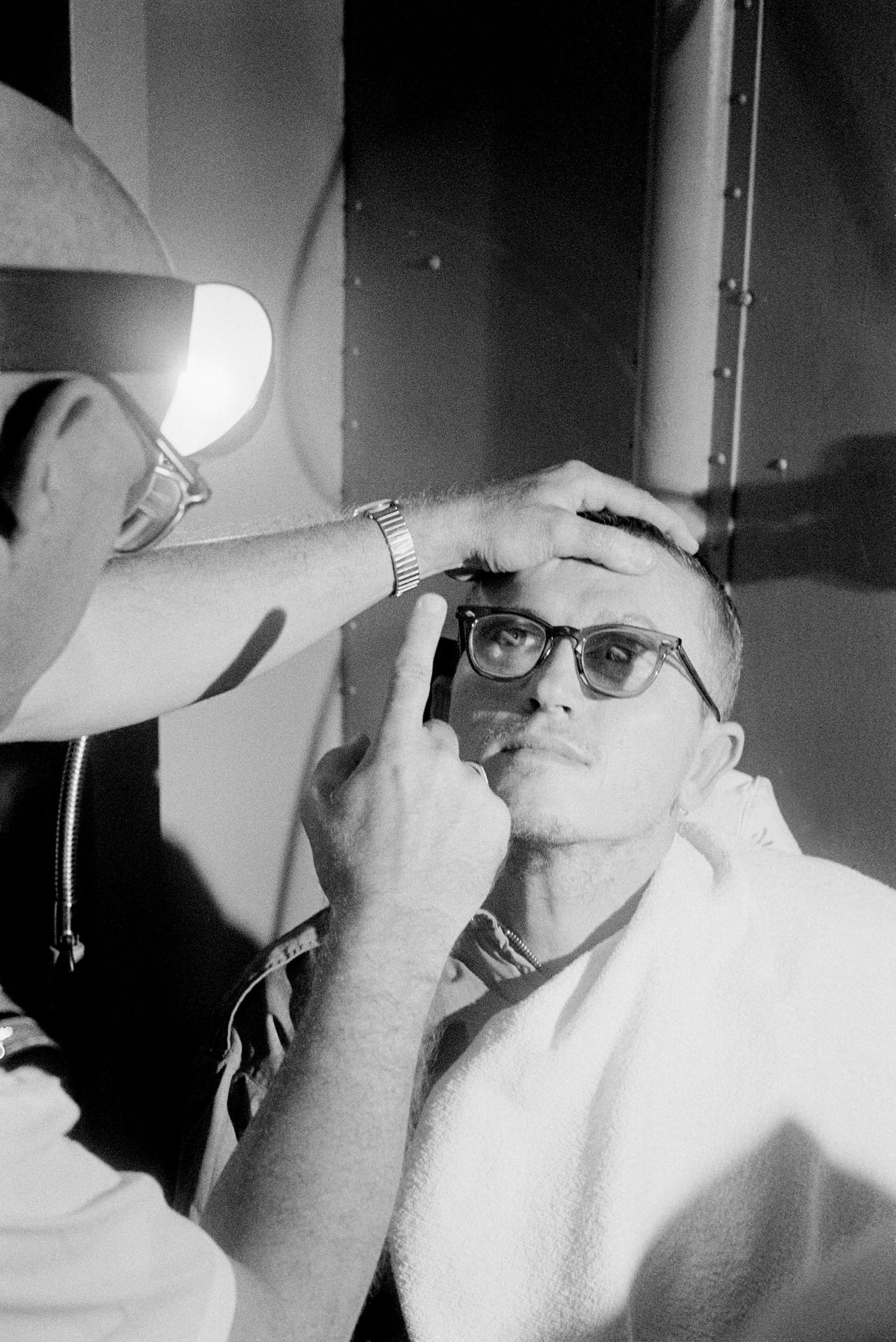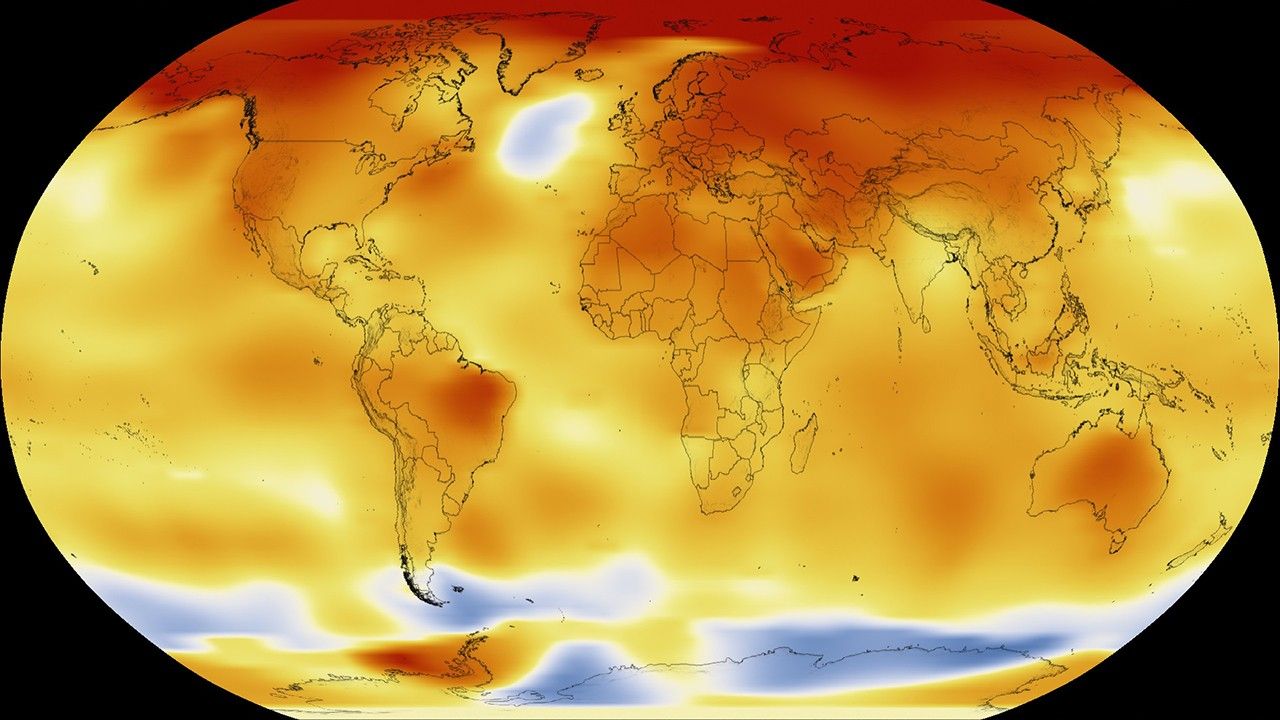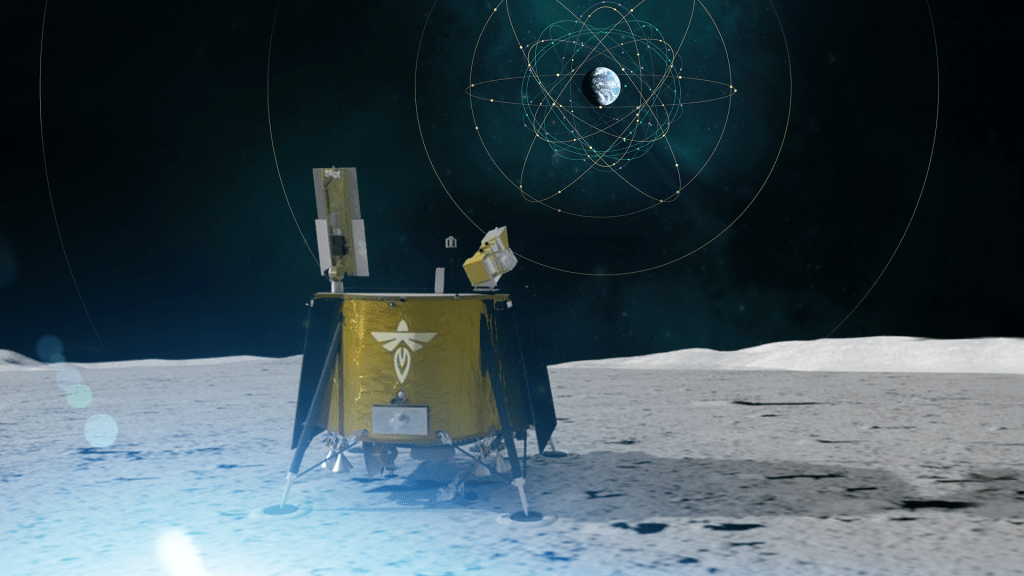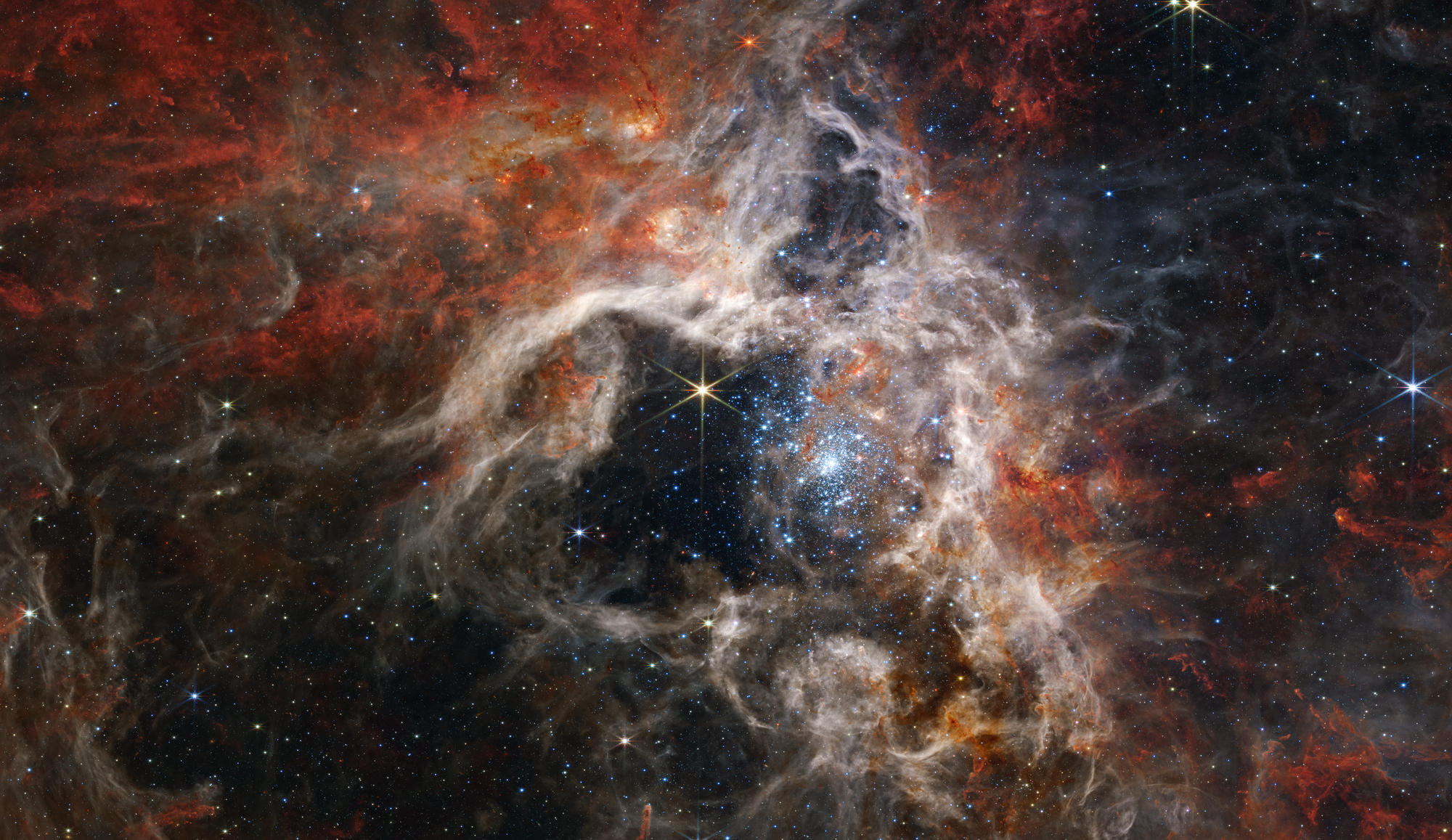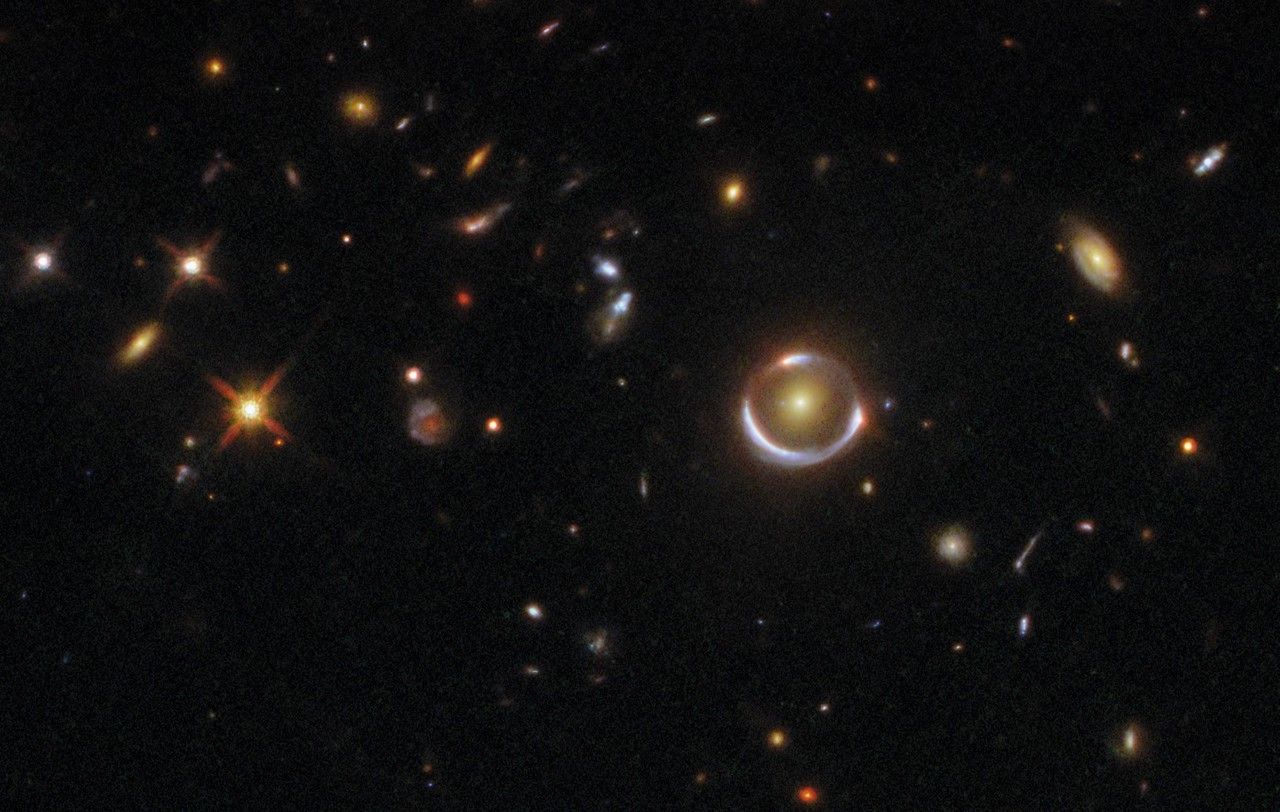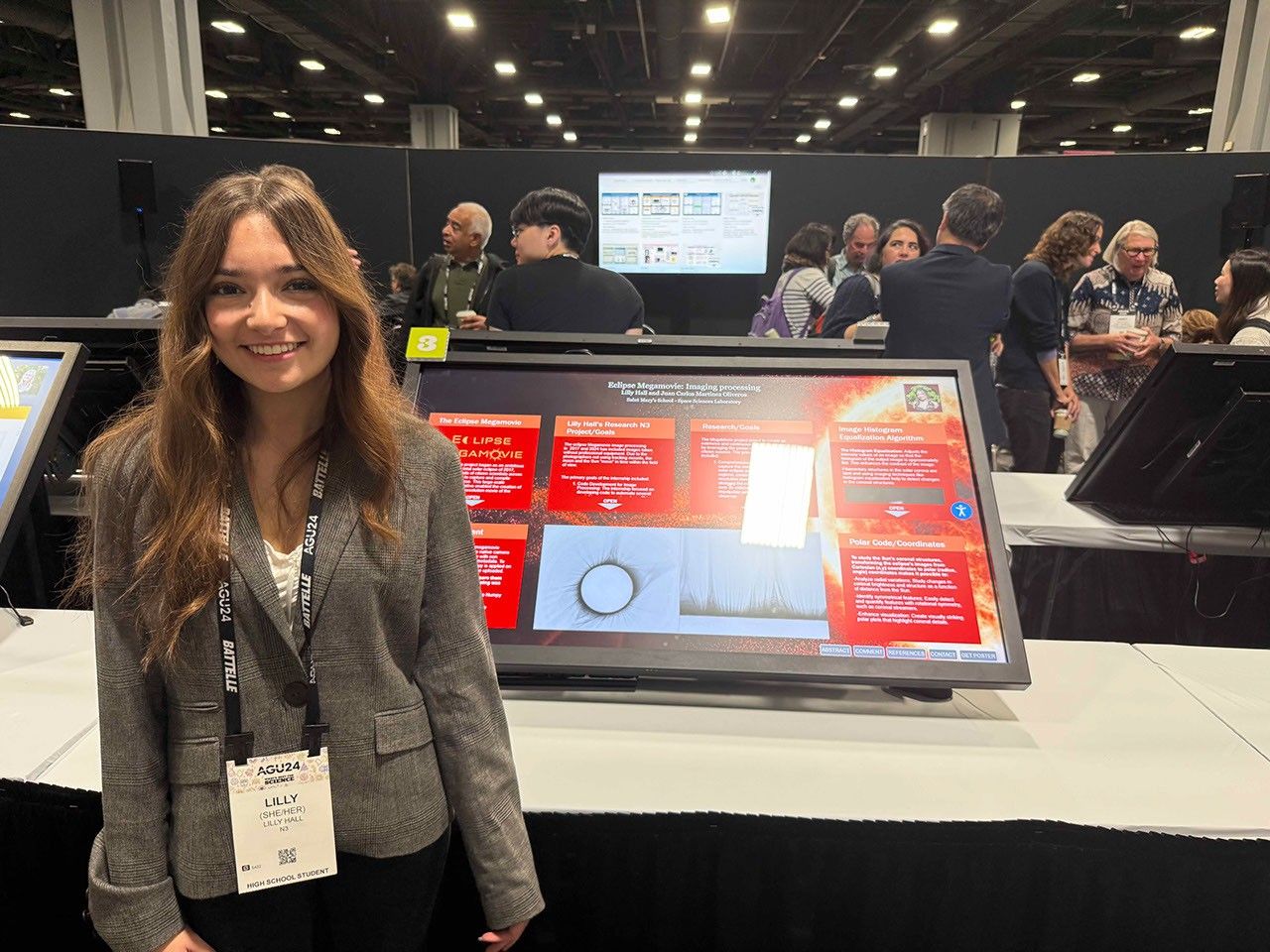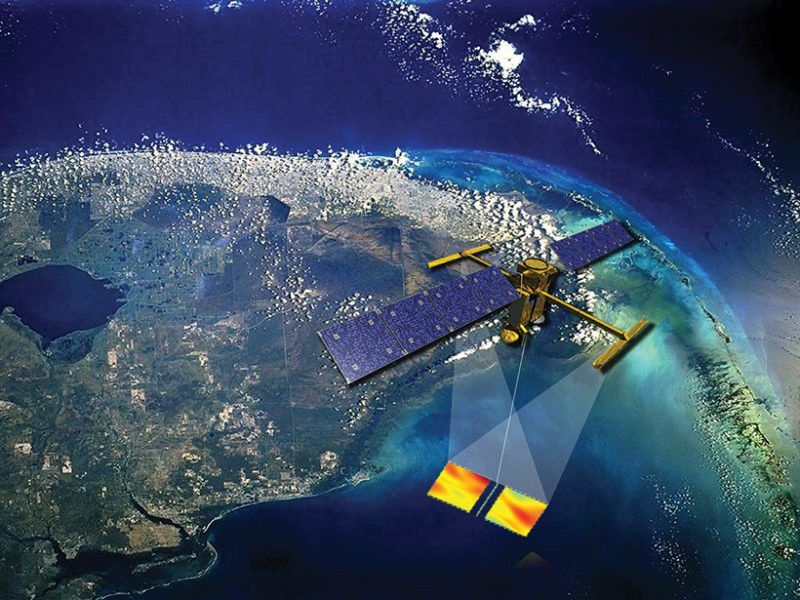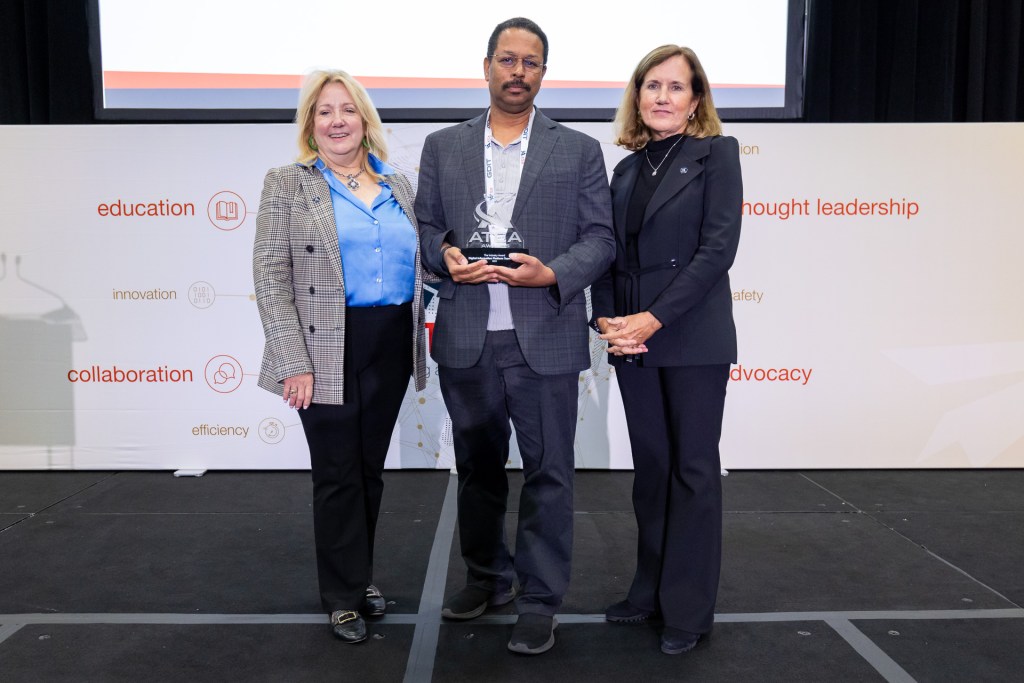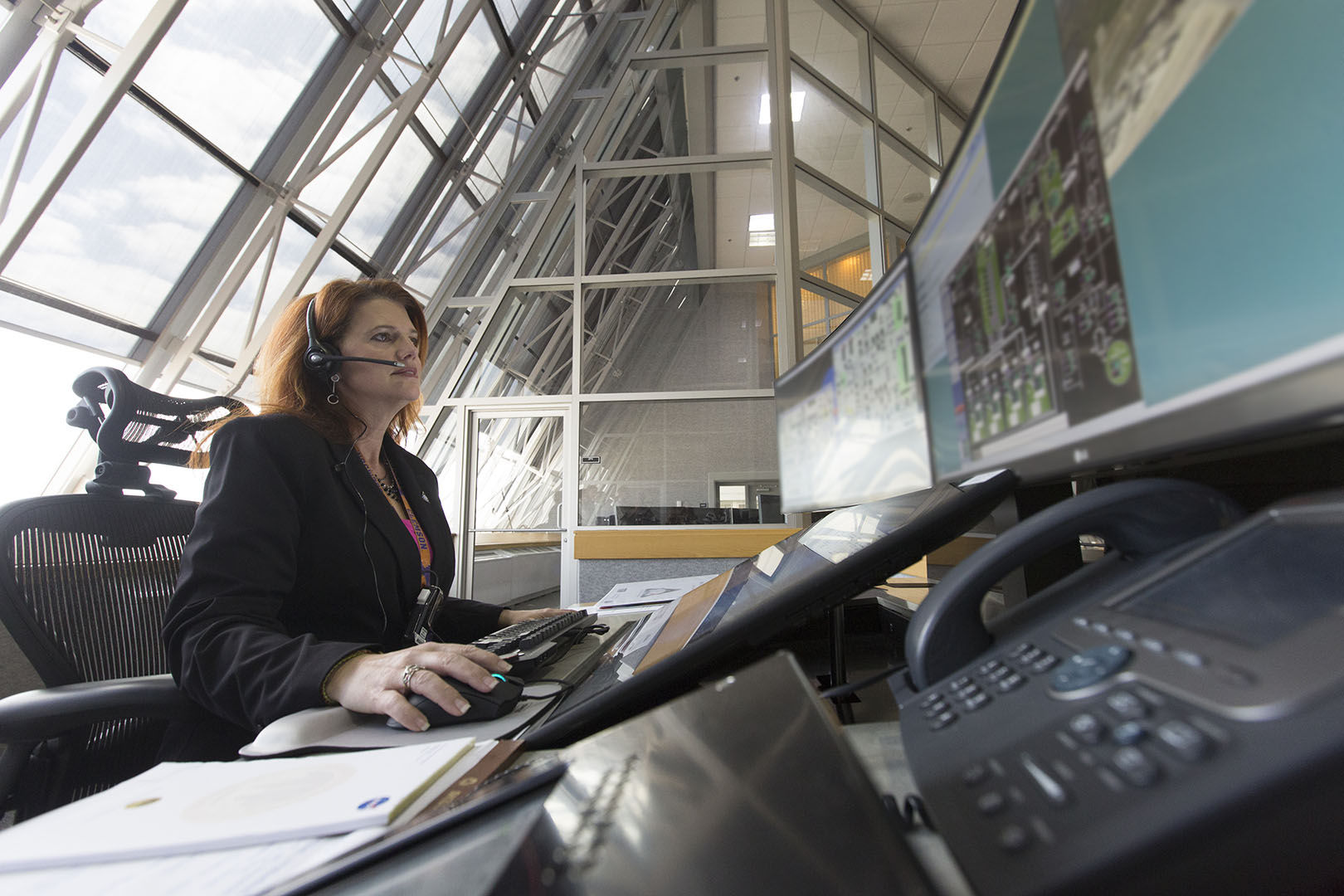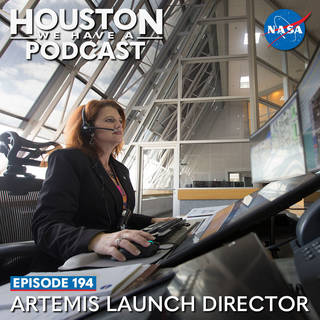
If you’re fascinated by the idea of humans traveling through space and curious about how that all works, you’ve come to the right place.
“Houston We Have a Podcast” is the official podcast of the NASA Johnson Space Center from Houston, Texas, home for NASA’s astronauts and Mission Control Center. Listen to the brightest minds of America’s space agency – astronauts, engineers, scientists and program leaders – discuss exciting topics in engineering, science and technology, sharing their personal stories and expertise on every aspect of human spaceflight. Learn more about how the work being done will help send humans forward to the Moon and on to Mars in the Artemis program.
On Episode 194, Charlie Blackwell-Thompson, launch director for the Exploration Ground Systems program at NASA’s Kennedy Space Center, shares the highlights of preparing for the first Artemis mission and the first launch and test flight of the Space Launch System with the Orion spacecraft. This episode was recorded on April 15th, 2021.
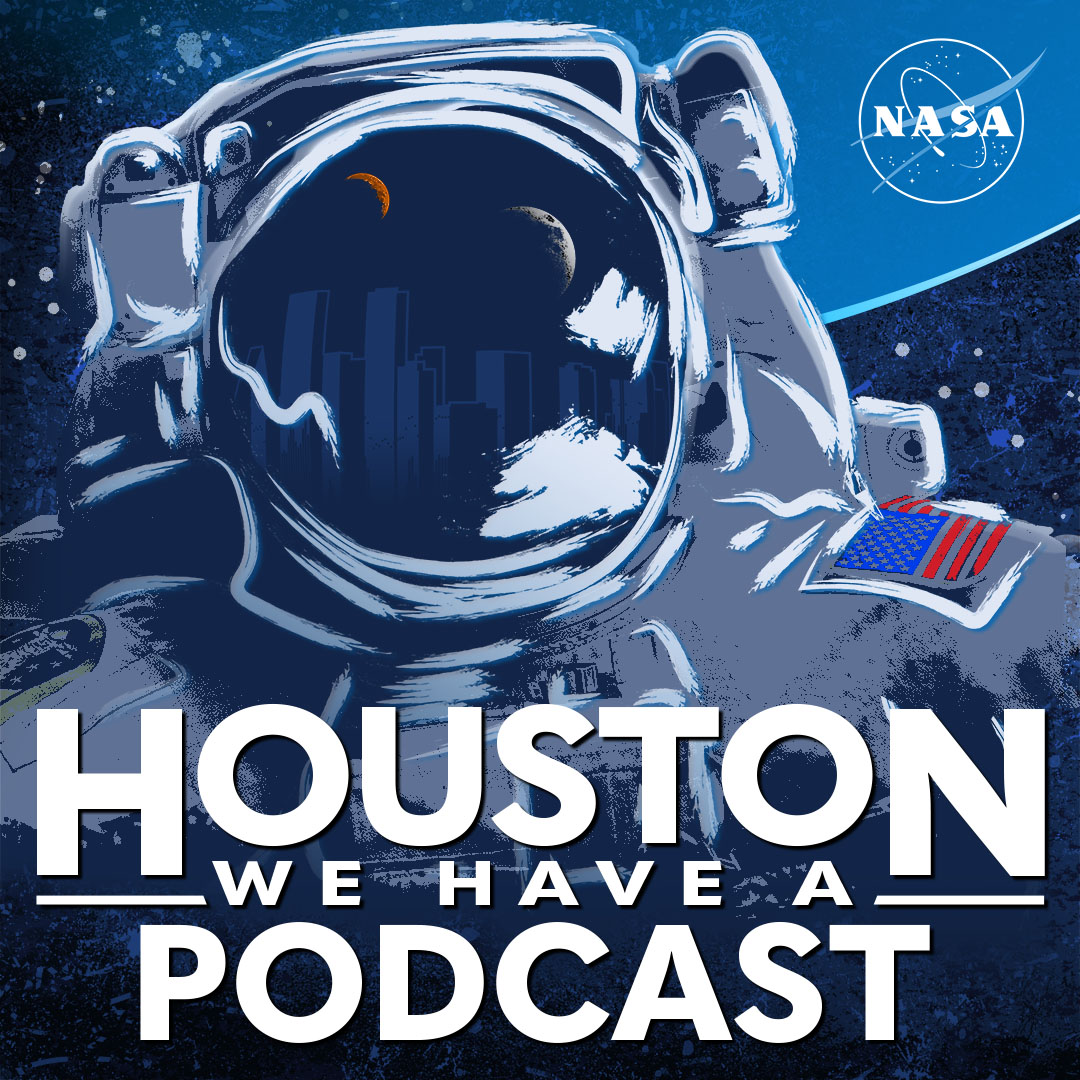
Transcript
Pat Ryan (Host): Houston, we have a podcast. Welcome to the official podcast of the NASA Johnson Space Center, Episode 194, “Artemis Launch Director.” I’m Pat Ryan. On this podcast we talk with scientist, engineers, astronauts, and other folks about their part in America’s space exploration program. Today, we’re going to take another step in learning the details about the upcoming first flight of the Artemis program. NASA’s Artemis program is focused on returning American astronauts to the Moon through the use of the Space Launch System rocket, the Orion spacecraft, the Gateway lunar outpost, a new lunar lander, and the ground systems that support them all. Artemis is about going to the Moon in a sustainable way: that is, to go to the Moon to stay and learn how to support astronauts in that environment; in the process, getting ourselves ready to go on from there to Mars. Back in January, Gary kicked off the series by talking to the Artemis mission manager, Mike Serafin, to get us started understanding what all is involved, and this week, we take another step. When Artemis I launches on the first test flight of the SLS with Orion atop, that launch team will work under the direction of Charlie Blackwell-Thompson, the launch director for the Exploration Ground Systems program at the Kennedy Space Center. A veteran of more than 30 years in the business at KSC and NASA’s first female launch director, Blackwell-Thompson started her career with Boeing as a payload flight software engineer and worked as lead electrical engineer for multiple Hubble Space Telescope servicing missions before joining NASA as a test director in the launch and landing division in 2004, working prelaunch processing, tanking, and launch countdown operations. We’ll talk about the cool jobs on her resume and what it’s been like getting a new program up on its feet to return American astronauts to the Moon, and the things that we should all be looking for when we watch that first Artemis launch. Artemis I Launch Director, Charlie Blackwell-Thompson. Here we go.
[Music]
Host: When we’re starting with a topic like Artemis, something that’s pretty new, I think it’s important to make sure we understand what we’re talking about and make sure that we don’t leave people behind, assuming that they know things that maybe we know, so Charlie Blackwell-Thompson, tell me what is Artemis, and what is the goal of this new program?
Charlie Blackwell-Thompson: Well, Artemis is a really exciting program that we have here at NASA, and it’s all about returning our country to the Moon, and this time, in a sustainable way, where we can learn to live off of our home planet in preparation for other deep space destinations, and so, you know, we are getting ready for humanity’s next great leap, which is sending our astronauts to Mars, so it’s a really exciting program for us here in the near term and also for generations to come.
Host: That’s a great and succinct explanation of it because sometimes, some people want to pretty it all up, but it’s that simple. It’s, we’re going to the Moon to get ready to go beyond the Moon.
Charlie Blackwell-Thompson: That’s right. That is right.
Host: Why is going to the Moon important? What are we going to be able to learn there that we don’t already know that we need to know?
Charlie Blackwell-Thompson: Well, it really is about learning. You know, with each exploration initiative, there comes scientific discovery, you know, technology advancement, and along with it, just inspiring a whole new generation toward exploration in STEM (science, technology, engineering, and math), and so, if we look back at Apollo, you know, we’re still learning from the samples that we collected during that program.
Host: Right.
Charlie Blackwell-Thompson: And so, if you kind of fast forward and think about all that we’re going to learn as we move forward, and we visit new destinations on the lunar surface.
Host: The Artemis program, as I understand it, is structured into a couple of big subgroups. Can you give me the thumbnail explanation of what those different components are that make up the Artemis program?
Charlie Blackwell-Thompson: Absolutely. So, you know, we talked about Artemis is about returning humanity to the Moon. Well, to do that, you need an incredible launch vehicle, and so, our sister program SLS has been developing the flight hardware, the flight elements that make up that very powerful rocket, and likewise, our sister program Orion has been developing the spacecraft that will take our crews into deep space, deeper than we’ve ever gone before, and so, while Orion and SLS are developing those flight capabilities, my home program, EGS, has been busy developing the systems to support this flight hardware during the prelaunch and the recovery phase, so we’ve been developing ground systems, enhancing infrastructure, all in preparation for this flight hardware and the processing of it, the integration of it together, the testing of it, and then ultimately, the launch of this Artemis vehicle.
Host: For the benefit of people who aren’t aware, SLS is Space Launch System?
Charlie Blackwell-Thompson:Yes, it is.
Host: And EGS, that’s your program. That is…
Charlie Blackwell-Thompson: Exploration Ground Systems.
Host: Tell me what’s included in — it sounds like everything that doesn’t fly?
Charlie Blackwell-Thompson: Pretty much everything that doesn’t fly. If I were to talk about the changes that we’ve made here since the Space Shuttle Program as an example.
Host: Right.
Charlie Blackwell-Thompson: One that’s really near and dear to my heart is right here in the Launch Control Center. When you think about the work that exploration — when I talk about the work that Exploration Ground Systems has done, I’ll kind of touch on the different elements. So, a lot of the facility assets and some of the equipment that we use is from the shuttle program, but the capabilities and the needs of this rocket and spacecraft are really different. So, in the Launch Control Center, we have modernized the Firing Rooms, both Firing Room 1, 2, and 3. Firing Room 1 and 2 are used on day of launch. Firing Room 1 is our prime and our launch-capable Firing Room. If you’ve ever visited Firing Room 1 back during the shuttle program, you may remember that it had some Apollo-era blue furniture there. That’s all been removed and —
Host: OK. [Laughter]
Charlie Blackwell-Thompson: — replaced with more modern designs, and along with it is also a new suite of software. The shuttle-era software that we had in the Launch Control Center was designed back in the ’70s timeframe, ’70s and ’80s, and so, we’ve replaced that with newer computing capability and a suite of software that we — that is really designed specifically for the SLS rocket, the Space Launch System rocket, and the Orion spacecraft. So, here in my home facility, a lot of changes have been made, but it’s not limited to the Launch Control Center. If we were to step over to the VAB as another example —
Host: Vehicle Assembly Building, right?
Charlie Blackwell-Thompson: Vehicle Assembly Building. That was our final integration point for shuttle, so back during the shuttle program, we worked on the orbiter over in the Orbiter Processing Facility and then we would roll it over and it would get integrated with the external tank and the boosters in the VAB, the Vehicle Assembly Building —
Host: Mm-hm.
Charlie Blackwell-Thompson: — and get checked out and then we would go out to the pad for launch. The VAB is also our final integration point for the Artemis vehicle —
Host: OK.
Charlie Blackwell-Thompson: — but that’s where you have your access, your primary access to the vehicle in the vertical and so, if you think about the outer mold line of the shuttle, how different that is from the vehicle that we have, which is an in-line vehicle that stands over 300 feet tall.
Host: Yeah. It’s a rocket, as people traditionally think of rockets. It’s one long tube. Well, in this case, it’s got some attachments, but it doesn’t look at all like a space shuttle.
Charlie Blackwell-Thompson: Correct. And so, if you were to imagine that you had set of platforms in the VAB that extended out to give you access to the shuttle —
(Launch Control Center page is heard in the background)
Host: And we’ll point out, well, that you’ve mentioned a couple of times, being in the launch facility, that’s where you’re actually right now, while we’re talking, and that’s that sound, we’re hearing.
Charlie Blackwell-Thompson: Yes, it is.
Host: So, we were talking — you were talking about the facilities inside the VAB that were there specifically for space shuttle, which I guess, you’re going to say are things that you don’t need now.
Charlie Blackwell-Thompson: Right. And so, the access to the vehicle is really different and so, the platforms that are over in the Vehicle Assembly Building that were there in the shuttle era have all been removed, but they’ve been replaced with new access platforms because the needs and the requirements are very different based on the outer mold line shape of the vehicle, and so, there’s been quite a few changes over in the Vehicle Assembly Building, in the platform set that’s available, in the services that you provide to the rocket itself and the spacecraft, and to those interface points with which they are provided, so quite a few changes over there. One of the other fairly significant changes is that — is the mobile launcher itself. The mobile launcher serves as our launch platform.
Host: Right.
Charlie Blackwell-Thompson: We utilize it in the VAB. It also serves as an interface point to the vehicle for critical services, and it rolls, you know, we roll it to the pad, and it remains with the vehicle for launch. So, some fairly significant changes in the Vehicle Assembly Building. Likewise, out at the pad, you may recall that during Apollo and shuttle, we had a lot of service structure that was in place there and that’s been —
Host: Oh, yeah.
Charlie Blackwell-Thompson: — that’s been removed. We have a clean pad concept that allows for reduced operations and maintenance cost over the long term. You know, our launch facility sits on the beach and so, it’s exposed, and so we’ve found over time that the clean pad concept reduces those costs and so, helps with those operations and maintenance areas and so, we have a clean pad, so it looks really different than Launch Complex 39B looked during the shuttle era.
Host: You mean less hardware out there that’s exposed to the elements.
Charlie Blackwell-Thompson: Absolutely, absolutely.
Host: And that doesn’t — so it’s — there’s less out there to be degraded by them or to have to undergo costly repair.
Charlie Blackwell-Thompson: Correct.
Host: OK.
Charlie Blackwell-Thompson: Correct.
Host: OK.
Charlie Blackwell-Thompson: And so, there’s been a lot of changes and then certainly, last but not least is our crawler-transporter, you know?
Host: Yeah.
Charlie Blackwell-Thompson:It’s been in service for a very long time. We used it during Apollo, we used it during shuttle, and we intend to use it during Artemis, but it has gone through some upgrades to prepare it for the increased weight of this vehicle, and we have certainly utilized it several times as we have rolled the mobile launcher out to the pad for various verification and validation testing that we’ve done over the last year or two. So, all of our GSE, some of it is brand new because it supports the unique requirements of the vehicle, but some of the infrastructure and maybe big pieces of hardware that folks would be familiar with back from the shuttle program, they’re still in service. They’ve just been given a bit of an overhaul.
Host: And GSE, is that Ground Support something?
Charlie Blackwell-Thompson: Equipment, yes.
Host: GSE.
Charlie Blackwell-Thompson: Ground Support Equipment.
Host: I got you. Cool. And Charlie, you are the launch director in Exploration Ground Systems. You’re going to be the launch director for the first flight, for Artemis I. Tell me what the job means? What does it entail?
Charlie Blackwell-Thompson: Well, the first thing it means to me is that I’m really lucky, right?
Host: Yeah.
Charlie Blackwell-Thompson: Really lucky to have this amazing opportunity and to work with such an incredible group of people. You know, firsts don’t come along that often and to be at the beginning of a program that is going to take the first woman and the next man back to the Moon is pretty special. It’s pretty special to me. The responsibilities of the launch director is to make sure in the planning phase that we have the products, the services, the capabilities and our team is ready for launch, and those are pretty, pretty broad descriptions, but when I talk about things like products, it’s the launch countdown procedure, it’s developing the, you know, the steps, the — very specific steps that we will go through within our launch countdown for configuring the ground equipment, configuring the flight vehicle, checking it out.
Host: The instruction manual, it tells you how to —
Charlie Blackwell-Thompson: The — it is. It is the instruction manual, and so, we have to go put that together. We have to establish the timelines. I mean, we are working toward a launch window that opens and we want to be ready when that launch window opens, and so we also want to make sure that our timelines are put together and that we measure ourselves against those timelines as we go through launch because we have some areas where we can catch up, but we also have some areas for what we call critical path which is, you know, we really need to do these things in a very specific order, in a very specific timeline, and so, it’s putting that timeline together. It’s also the development of our launch commit criteria, which is the rules with which we are go or no-go on launch day and so, those are the things, and I talk about products, those are some of the specific things that I’m talking about.
Host: Right.
Charlie Blackwell-Thompson: When I speak about capabilities, it’s ensuring that our capabilities are in line with our day of launch needs, and capabilities, again, is another really broad category, but it’s things like, you know, the nets that we talk on, right? We have to be able to talk to our team across a number of different channels, have to be able to talk to the flight control team that’s back at Johnson (Space Center), have to be able to talk to the engineering design centers and so, it’s ensuring that we have all of that capability in place for launch day. It’s sometimes a simple — and that’s a pretty complex capability.
Host:Yeah.
Charlie Blackwell-Thompson: It’s some simple capabilities, too, which are, you know, what are the platforms that we’re running our electronic procedures on? And do they allow us to very, you know, easily work our way through the steps and buy them off and for our team to have visibility to that? So, it — capabilities is a pretty big bucket that there’s a lot of different things in that, but it’s ensuring that all that we need on launch day is in place and is working for us.
Host: It sounds like it’s not just strictly any communications capabilities, but any sorts of systems that support the work that all of these people who are working the launch need in order to succeed, to complete that job.
Charlie Blackwell-Thompson: Absolutely. And then, there’s the team piece, of course, which is, you know, is our team ready? So, you know, do we have our products in place? Do we have our software done? Do we have our procedures ready? But it’s also, is our team ready? And so, we have a suite of training that we do with our team to ensure, we do simulations, very similar to what the flight control team does except ours are very focused on the prelaunch phase, but we will go through our operations a number of times with our launch team to ensure that we’re ready for our nominal launch countdown and we’re also ready for any problems that may arise on launch day and that we have the right, what we call preplanned contingencies in place, but it’s really a “what’s our plan?” if this happens? How do we go —
Host: If something goes wrong.
Charlie Blackwell-Thompson: — work through it?
Host: Yeah. What are we going to do if something goes wrong?
Charlie Blackwell-Thompson: Yes.
Host:Mm-hm.
Charlie Blackwell-Thompson: And can we get ourselves to a go or no-go state? Are we done for the day when this problem arises or do we have some things we can go do, some redundancy we can employ, some additional capability, that allows us to go fly the vehicle?
Host: It sounds like you’re talking about education. You’re teaching everybody who’s a member of that team to know everything about their particular area of expertise and then, how everyone would work together to respond to something that was unexpected.
Charlie Blackwell-Thompson: Absolutely. You know, we’re teaching each other.
Host: Yeah.
Charlie Blackwell-Thompson: We’re all learning together as part of those simulations and those training exercises.
Host: Being the launch director responsible for the development of all of that sounds like a heck of a big responsibility. Tell me about how you got yourself ready to take that up. Tell me about your background, what was your professional path that got you here?
Charlie Blackwell-Thompson: Absolutely. I’m happy to share that. So, I came to Kennedy Space Center as a senior in college. I was lucky enough to get an interview with one of the contractors here at KSC that was responsible for the processing of payload flight hardware. And when I was in school — I have an engineering, I’m a computer engineering major — and one of the areas that I was interested in, in school was software. I didn’t want to write code. I knew that that was not my thing —
Host: Right.
Charlie Blackwell-Thompson: — but I was interested in testing it and in doing verification and validation and so, I was lucky enough that in one of my interviews, I had mentioned that I wanted to do the software testing and one of the contractors was looking for someone that was interested in doing software testing and so, I got a call back and they brought me here to Kennedy Space Center and absolute, you know, thrill to be here —
Host: Yeah.
Charlie Blackwell-Thompson: — to be able to see the space shuttle orbiter, but when I walked in — and it’s not lost on me that it was Firing Room 1, which by the way, is where we’re going to launch from —
Host: Right.
Charlie Blackwell-Thompson: — but when I walked in Firing Room 1, the team was preparing space shuttle Discovery for Return to Flight after Challenger —
Host: Oh.
Charlie Blackwell-Thompson: — and I was just struck by the work that they were doing. I wanted to be a part of that team. I wanted to earn myself a seat in the room, and I was lucky enough over time, to do that, and so, I started. I was working in software and I did that for a couple years. I moved up to work on not just payload flight software but to work on avionic systems on payloads that were flying in the space shuttle, so I got to work on them offline in their avionics integration and tests and then I got to come when they were installed in the space shuttle, I got to come and check out the communications and the avionics interface between —
Host: Cool.
Charlie Blackwell-Thompson: — the payload systems and the orbiter systems.
Host: You got to put your hands on the space shuttle.
Charlie Blackwell-Thompson: I did, and I also got to put my hands on the payload flight hardware, so I got an opportunity over the course of my career — I can’t really believe how incredibly blessed I’ve been — I got to work on Hubble Space Telescope.
Host: Oh.
Charlie Blackwell-Thompson: I got to work on the servicing missions that followed —
Host: Uh-huh.
Charlie Blackwell-Thompson: — the International Space Station assembly elements, some awesome observatories, Gamma Ray Observatory, some planetary missions, so just really had — and you know, each of them were different so, it was always something to go learn.
Host: Nice.
Charlie Blackwell-Thompson: And after I did that for about 15 years, I had an opportunity to move over to NASA in the civil servant workforce and become a test director, and I took that opportunity and that was a huge change from working in payloads and working in command and data handling and electrical systems, and moving over to the test director office, but it was a great opportunity for me to learn to kind of look more broadly across shuttle processing, and so I did that until the shuttle program ended. I became a certified — a launch-certified NASA test director so I had an opportunity to launch from that position, a number of times, and stayed either in the NTD role or the chief NTD role, which is NASA test director, or the assistant launch director role, until the end of the program. So had a lot of time in the Firing Room. After shuttle ended, I led a division within the ground processing directorate and that was a lot of really good work, gave me a lot of new skills, but I was always called back to that Firing Room and always called back to the flight hardware and so, a few years ago back in 2016 I got an opportunity to start helping. or I guess in 2015, start helping with the launch planning for the Artemis vehicle, and so here I am.
Host: There you are. Do you have any good sense yet, and granted, you haven’t actually launched an Artemis mission, but as you’re getting ready for it, do you have a sense of whether being the Artemis launch director is significantly different than being the launch director for other kinds of rockets or missions that launch at Kennedy Space Center?
Charlie Blackwell-Thompson: I would say that the role is — because I had a firsthand view, although I did — I wasn’t a launch director in shuttle.
Host: Right.
Charlie Blackwell-Thompson: I was an assistant launch director, but I had a firsthand view of what the shuttle launch director did, and so, I would say, it’s similar, not quite the same, but if I were to pick most similarity I would say it’s very similar to the role of the shuttle launch director.
Host: OK. A few minutes ago you were, started going through some of the process of what the Artemis launch director preparing for the first mission, the kinds of things that you’ve had to do. You’re talking — are there — were there other changes on ground systems that we hadn’t gotten to yet? Are there other things than, besides the VAB and the crawler-transporter, big changes that you’ve made?
Charlie Blackwell-Thompson: I would say those are the, probably the biggest is that, you know, we have mobile launcher that provides those critical services. I didn’t talk a whole lot about that. That was repurposed from the Constellation program. The biggest, most visible changes are in the VAB, out at the pad, and I would say in the Launch Control Center, but certainly —
Host: Yeah.
Charlie Blackwell-Thompson: — across the center, there are changes within each of those major facilities that are very unique to support to this vehicle. I mean, new, when I talk about ground support equipment, there is a suite of ground support equipment that has been either upgraded, changed, enhanced to support the needs of this vehicle, and when I talk about that it’s everything from, you know, the purges on the vehicle to, you know, the software in which we control certain functions. It’s just across the board, really significant changes because the needs of this vehicle are quite different than what we had back in shuttle, and even in the cases where it may be similar, you know, some of the equipment from shuttle had been around for a really long time and was really in need of upgrade, either for obsolescence reasons —
Host: Right.
Charlie Blackwell-Thompson: — or just, you know, maintainability reasons.
Host: You’re developing a system that is specific to the needs of the rocket that you’re launching, the rocket and the spacecraft that you’re launching. By the way, is the Artemis I launch director much involved in the development of the rocket and the spacecraft itself?
Charlie Blackwell-Thompson: Well, I would say that our sister programs SLS and Orion are responsible for the development of the rocket and the spacecraft. Where the launch director comes in is when we begin to talk about the launch operations and kind of keeping the end in mind. It’s in that requirements development piece, I would say. It’s in formulating some of the capabilities that we need, so we are involved. It’s not our direct responsibility but —
Host: Right.
Charlie Blackwell-Thompson: — certainly, when we think about launching the vehicle, we, you know, we have to think about well, what do we need and what is the timeline in which we need to do this? And so, we are involved in those design discussions and decisions, you know, from a making an input for — maybe it’s for operability. Hey, for launch, you know, if we could do it this way, this would be a great help to us because we are constrained, you know, by either the timeline or maybe by other work, so it’s really important to be a part of those discussions in the development phase because elsewise, you know, you get it and then you kind of got to make do with what you have in terms of this is what the work takes. So, it’s really a partnership between the operations team and the development team, you know? The development team’s responsible for developing the flight hardware, but the operations team is, you know, is invested in providing the inputs of this makes it much easier for us on the ground in the prelaunch phase or in the launch phase, if we do, you know, solution A versus solution B.
Host: You don’t want them to develop a system that is hard to operate.
Charlie Blackwell-Thompson: Correct.
Host: Yeah. The first flight of Artemis, the first Artemis flight, or the next flight, is not going to have any astronauts onboard, so are there significant developments in, or differences, in developing procedures for a flight with no astronauts as opposed to the subsequent flights, which all will have people onboard?
Charlie Blackwell-Thompson: That’s a great question. There are differences. The great thing is, you know, we expect to get a really solid baseline from Artemis I on what it takes to configure the ground, what it takes to configure the SLS rocket, the upper stage, and Orion to some degree, from Artemis I, and once we write those procedures, I’m a big fan of we write it once, we use it many times, because once you write it and you use it and you iterate on it, it’s kind of working from a proven product and so, to me, that’s the great thing about utilizing our launch countdown procedures between Artemis I and Artemis II, but there are absolutely differences. The most notable, of course, is when we close out the crew module, so for when we have crew, just like you see for some of the other vehicles and we saw in shuttle, is that after, in the later part of our countdown, for us in Artemis after we get finished with our tanking phase, you know, the crew will go to the pad. We’ll have crew ingress and then we will go through our crew module close out where we do comm[unication] checks with the crew, we finish out our work in the crew module and we begin backing out, closing the hatch and then leaving the pad in preparation for launch. On Artemis I, we don’t have that work to do and so, we’re all about, you know, buying down schedule risk and technical risk as we go, so we can close that crew module out before we ever tank the vehicle and so we’ll do that on Artemis I. So, that would be the biggest change between Artemis I and II is that you won’t see that activity post-tanking for Artemis I. We’ll have the crew module buttoned up, we will have closed out the White Room, we’ll have closed the hatch before we ever leave the pad for tanking on Artemis I, so that’ll be a big difference for Artemis II, and it will certainly add some time into our timeline as well.
Host: Or there’s less things to do so the timeline will be a bit shorter.
Charlie Blackwell-Thompson: For Artemis I, that is correct.
Host: Yeah. Let’s talk more about Artemis I. Tell me — I referred to the fact that there’ll be no people onboard, but you tell me, what are the objectives of this first flight in the Artemis program?
Charlie Blackwell-Thompson: So, the objectives of Artemis I is we’re building a capability, right? We’re building a capability to send people back to the Moon, and so Artemis I is about testing out some of those capabilities that we need before we send crew into space, and one of the primary capabilities that we’re testing out is the integrated vehicle, and the performance and the capabilities of it, because it’ll be the first time that we have launched the SLS rocket with the upper stage, with the Orion spacecraft and —
Host: Right.
Charlie Blackwell-Thompson: — so we’ll be testing out that capability. The other piece is the Orion heat shield and how it performs as we go through re-entry, and so I know that my flight director friends will probably talk to you more about that when you talk to them, but those are two of the big objectives as part of Artemis I, and then there’s some other objectives related to some payload activities, and then of course the recovery of the Orion spacecraft at the end of the mission. So, it’s, in the simplest of terms for Artemis I, it’s about testing out critical capability that we will then, once we know that that critical capability is in place and is sound, we’ll be ready to put crew on Artemis II, and then, certainly, sending the crew into deep space and checking out the capability there of the spacecraft and how it all performs with the crew interface and the additional systems there and then getting ready for Artemis III and boots on the Moon, so it’s an incremental approach for how we build this capability toward returning to the Moon.
Host: Is the launch director particularly interested in what happens after you get it off the ground?
Charlie Blackwell-Thompson: Oh, I absolutely am.
Host: That’s not your responsibility anymore, right?
Charlie Blackwell-Thompson: It is at liftoff, at booster ignition and liftoff, the launch director hands off to the ascent flight director.
Host: Right.
Charlie Blackwell-Thompson: And so, from a — are you directly involved? The answer’s no, I’m not. Am I interested? Absolutely, because we’re all stakeholders in this and, you know, it really is in some ways like you’re handing the baton to your partner and —
Host: Relay, yeah.
Charlie Blackwell-Thompson: — you know, you want to hand them the best vehicle, the most capable vehicle that you can, and likewise my flight director friends want to hand that, you know, that vehicle back to the landing recovery director at the end and so, we are all partners in this together and, you know, certainly like the nation will be, I will be watching with intrigue and wonder —
Host: Oh, yeah.
Charlie Blackwell-Thompson: — as we go through the different phases of the mission.
Host: Help us, all the rest of us who don’t know yet, help us understand what happens leading up to that launch. Pick some point at, you know, a launch minus however far you want it to be, and give me the story of what’s going to happen there around the Kennedy Space Center and what sorts of events and milestones are going to happen as your team gets this vehicle ready to fly?
Charlie Blackwell-Thompson: Well, so let’s see. I could start at any point, I would say and —
Host: Pick one.
Charlie Blackwell-Thompson: — in terms of — I’m going to say, let’s talk about, maybe in the — I’ll talk about some visible pieces in a moment, but if I were to say, step back, you know, a year, maybe —
Host: OK.
Charlie Blackwell-Thompson: — a year-ish, what are the things that we’re doing here to get ready for launch? Well, some of it I talked about already, but it’s the — it’s in development, it’s receiving the requirements from our flight element sister programs that say here is the services, here are the needs of this vehicle. And so, it is developing the procedures, it’s developing the software, it’s developing everything that we need to put these flight elements together and to test them out to ensure that they’re ready to go fly, and that’s not a small undertaking. That’s —
Host: No.
Charlie Blackwell-Thompson: — a fairly significant development effort in terms of the procedures and the software, and of course, you have to — you, even if I were to back up before that, before you get the flight hardware, you know, over the last many years, we have been developing these capabilities here at Kennedy Space Center for, to support the vehicle, and it’s sometimes it’s things that you may not think about. I’ll give an example.
Host: OK.
Charlie Blackwell-Thompson: We have out at the pad at launch, and you’ve probably seen this in the past, but at T-zero, or in and around T-zero, during the ascent phase, very close to being off the pad, right, there’s an acoustic environment that is created by the booster ignition and there’s a big sound wave that kind of bounces off of the deck, if you will, of the mobile launcher, and one of the very simple ways that we mitigate that to create any adverse effects of the vehicle is that we flood the deck with water.
Host: Right.
Charlie Blackwell-Thompson: Now that sounds pretty simple, but there’s actually a pretty specific timing sequence to that and when you want to have that deck flooded with water. If you flood it too soon, the water will have, you know, will have run off the sides and down —
Host: It’ll be gone.
Charlie Blackwell-Thompson: — through the flame trench and you won’t really have the covering that you need, and so while that sounds simple and easy, it requires testing and so, we have spent some amount of time kind of tuning, if you will, the start of the water and kind of the timing of it because we want to have it just right, and while that sounds pretty simple it turns out to be a number of different tests, you know, to get it exactly where you want it relative to T-zero, and so, there are many, many tests, many development efforts like that, that have been ongoing for many years. We are glad to be working our way through those and get them behind us because we’re excited about this flight hardware coming to Kennedy Space Center.
Host: I can imagine that it’s kind of the, you know, the more I learn, the more I realize I don’t know, and you got to work through those steps in order to figure out when is the right time to turn on the water and how much and from what directions, just as an example of the kinds of procedures that you’ve got to develop, even if just by trial and error.
Charlie Blackwell-Thompson:Correct, correct. And so, there’s all of that work that happens, I would say, you know, years before and probably not nearly as visible. The same thing is true with the software in the Launch Control Center. I mean, developing a new suite of software for a brand new vehicle while you’re building the flight hardware at the same time, you know, comes with some challenges, and so, you know, we’ve been developing that software, we’re just about to the finish line on it and so, you know, but that’s one of those things that kind of happens that is maybe not as visible, but starts many years before, but kind of bringing it back to what are the visible pieces that’ll be maybe here more in the near term —
Host: OK.
Charlie Blackwell-Thompson: — is a couple things. First, the core stage is due to arrive here very soon. They have finished up their Green Run testing. It was hugely successful. Our team was in Firing Room 1 following along during that testing activity.
Host: Uh uh.
Charlie Blackwell-Thompson: It was amazing to see that stage run the full duration, to see those engines light and gimbal and just run through that full duration run with something incredibly special. And for me, when that test was over and they were in post-cutoff safing, I couldn’t help but think, you know, the next time those engines light, it’s launch day.
Host: Mhhm.
Charlie Blackwell-Thompson: So —
Host: No more test firings of them until then?
Charlie Blackwell-Thompson: What’s that?
Host: There’s no more testing of them until then?
Charlie Blackwell-Thompson: There’s testing of the engines, but there’s no more firing —
Host: Firing of them.
Charlie Blackwell-Thompson: — of them.
Host: OK. Good. I didn’t realize that. That’s – yeah, that’s interesting to think about.
Charlie Blackwell-Thompson: Yeah. As a launch director, I often have — I’ve looked at things with a lens toward launch and so it’s not uncommon for, you know, for me to when I think about different milestones, I had the same thought during hot fire and during the wet dress activities, you know, when I was thinking about, you know, the next time we tank this vehicle it’s wet dress day, and the time we tank it after that is launch day, and so we are, you know, we’re really one tanking away from launch day.
Host: And if I can, when you refer to wet dress, that’s another step in the preparation of a test run of a sort.
Charlie Blackwell-Thompson: It is and that’s one of those — when we talk about big milestones, I talked about core stage getting here, which is the last piece of flight hardware for the Artemis vehicle. It’ll be the final piece, so everything else is here at Kennedy —
Host: Already there.
Charlie Blackwell-Thompson: — Space Center. Yup. And everything is in process, either in testing or in preparation phase, so when the core stage gets here very soon that’ll be — that’s a big deal for us, and then after it gets here, maybe not quite as visible milestones will be the integration of the hardware and the testing that follows in the VAB. I mean, all very important tests, right, we begin to put, the boosters are stacked up in the VAB right now and just waiting and so, the core stage will come, will get integrated with the boosters, the upper stage will get integrated up on top and then Orion up on top of that, and there’s a series of tests that we do — prior to rollout for wet dress rehearsal, but wet dress rehearsal and the rollout for it, I think will be a really big and very visible milestone for us as —
Host: Yeah.
Charlie Blackwell-Thompson: — an enterprise, because it means that the vehicle’s been fully integrated, the vehicle has been fully tested in the Vehicle Assembly Building, and we are ready to roll to the pad for wet dress rehearsal, and what wet dress rehearsal is, is a wet dress rehearsal for launch.
Host: OK.
Charlie Blackwell-Thompson: So, we will —
Host: And wet, that’s wet as opposed to dry and I’m taking that that has to do with fuel.
Charlie Blackwell-Thompson: It does.
Host: OK.
Charlie Blackwell-Thompson: So, we will go through the loading profile for both core stage and upper stage, so we will tank the vehicle. We will go through the launch countdown operations, down to terminal count, and then we will have a planned cutoff. So, we will go down to about ten seconds in the countdown and then we’ll call it a day, but it will be an opportunity to go in a wet environment to do a dress rehearsal for launch.
Host: OK. As you — as we — you get to — I’m thinking ahead to the actual flight, I guess, you know, the excitement. [Laughter] You want to think about that, but you said a moment ago that as the launch director, you actually hand off responsibility for the vehicle fairly soon after it gets off the ground. Are there any other responsibilities that your team has then all the way to the completion of the mission, or is that all the responsibility of the flight control teams?
Charlie Blackwell-Thompson: It is the resp — the flight phase is the responsibility of the flight control team. Now we are there to support them —
Host: Mm-hm.
Charlie Blackwell-Thompson: — because sometimes there are questions about, you know, did you see this on the ground or, you know, what did you guys observe during testing? And so, we are part of the Mission Management Team meetings that happen on a daily basis and so, we are absolutely there to support our flight control teammates, but in terms of the responsibility for the vehicle, it resides with them.
Host: Does Exploration Ground Systems then come back into play on any given mission once the vehicle returns, once the Orion returns?
Charlie Blackwell-Thompson: It absolutely does and it’s actually, there’s a handoff at the end of the mission, so the flight control team is responsible for the landing operations, but the recovery director, who is Exploration Ground Systems, and that’s Melissa Jones, she is responsible for the recovery of the spacecraft and the preparation of it to return here to Kennedy after the mission is done, and so, Melissa will have a team of folks that will be ready to make those recovery operations, and I think she’s — you’re also planning to talk to her a little bit about that — but absolutely, so we’re kind of on the front end of the mission getting ready for launch and then on the back end of the mission as we recover the spacecraft and bring it back here to Kennedy for processing and making ready for any future needs.
Host: So, as we look ahead through this year toward, you know, as we get closer to when Artemis I is going to happen, what kind of milestones would you maybe advise people to keep an eye out for? What big things are going to happen between now and then, that are sending the message that we’re getting closer, this is still happening, and we’re actually making progress here?
Charlie Blackwell-Thompson: Well, I think the milestone of core stage arriving here at Kennedy is a significant milestone for us because it means, not just to us, but to everyone that is watching that all of the flight hardware has arrived here. It is here at the launch site, and now it is in the final preparations for launch. Likewise, I think once the testing is done, I think that rollout for launch, a very visible milestone, is going to be an amazing sight when that vehicle rolls out of the Vehicle Assembly Building High Bay 3.
Host: And make sure that it doesn’t bump its head out on the way out, too.
Charlie Blackwell-Thompson: It is a — it’s a really tall vehicle and I have watched a number of rollouts. You know, as the launch director you are responsible for directing the team and leading the team during those roll operations and I’ve seen a number of vehicles roll past the windows of the LCC on their way to the pad —
Host: Yeah.
Charlie Blackwell-Thompson: — and I can’t wait to see this one for the first time, because it is going to be something incredibly special. I’ve been around a long time and it’s something I’m really looking forward to because I think it’s going to be something that I haven’t seen before, and many haven’t seen before in terms of just how stately this vehicle is going to look when it comes through those doors.
Host: It’s also got a terrific, symbolic importance because of where it’s going and what it’s going to do.
Charlie Blackwell-Thompson: Absolutely.
Host: Charlie Blackwell-Thompson, thank you so much for helping us understand better what’s going on at the Kennedy Space Center and what we’ll see when it comes time for Artemis to fly.
Charlie Blackwell-Thompson:You’re welcome. It’s been my pleasure to be here today. I hope you got a sense that this an incredible vehicle. It’s got an incredible mission. We’re excited here at Kennedy and, you know, I feel just extremely blessed to be a part of this, so thank you for letting me be a part of your afternoon.
[Music]
Host: Things are coming together more and more as the calendar moves closer and closer to the next launch for Project Artemis. Not happening as fast as some people would like, of course, but you can hear from the launch director that the folks on the ground are seeing progress and getting through the series of tests and in processing and assembly. The podcast will be working on future episodes that’ll let us bring you more details about these future missions. You can always learn more by going online to NASA.gov/artemis or NASA.gov/moontomars to keep up with developments and dig deep into the background. I can remind you too that you can go online to keep up with all things NASA at NASA.gov. It would also be a good idea to follow us on Facebook, Twitter, and Instagram too. When you go to those sites, use the hashtag #AskNASA to submit a question or suggest a topic for us. Just make sure to indicate that it’s for Houston We Have A Podcast, and you can find the full catalog of all our episodes by going to NASA.gov/podcasts and scrolling to our name. You could also find all the other good NASA podcasts right there at the same spot, NASA.gov/podcasts. This episode was recorded on April 15th, 2021. Thanks to Alex Perryman, Gary Jordan, Norah Moran, Belinda Pulido, and Jennifer Hernandez for their help with the production, to Kathryn Hambleton and Toni Jaramillo for making the arrangements, and to Charlie Blackwell-Thompson for helping advance our education on the upcoming flight of Project Artemis. We’ll be back next week.





